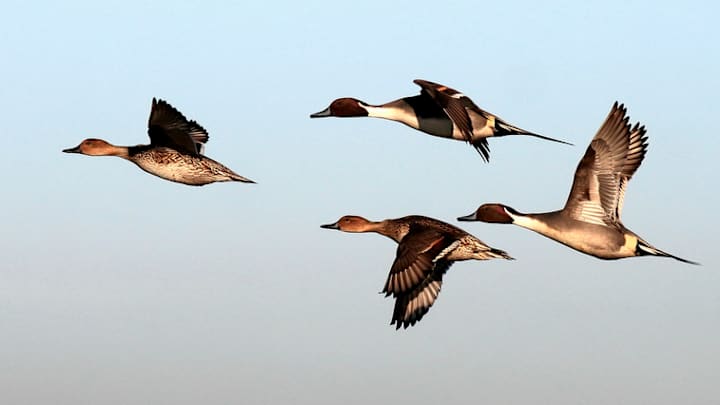You may have fed a few ducks in your lifetime, and maybe even seen a couple of ducklings waddling around in summer. But how much do you really know about these birds?
1. Ducks don’t mind cold temperatures.
Their webbed feet have no nerves or blood vessels, rendering them incapable of feeling the cold. This is an important adaptation when you consider that ducks can be found on every continent except for Antarctica.
2. Ducks lose their fancy plumage at least once a year.
Male ducks, a.k.a. drakes, develop breeding plumage in spring to attract females, a.k.a. hens. After they mate and are raising their ducklings, the birds molt their brightly colored feathers and take on a less flamboyant look.
3. Preening helps them stay dry.

Preening is the process by which ducks groom themselves to get rid of dust, dirt, and parasites from their feathers. It also helps them stay waterproof. As they preen, ducks spread a waxy oil, secreted by their uropygial gland, through their feathers to seal out water [PDF].
4. The amount of daylight affects how many eggs a hen produces.
The more daylight there is, the more eggs a hen produces. Farmers who raise ducks will often turn to red or white artificial lighting to give their hens at least 14 hours of light a day.
5. Ducks often eat gravel.
The birds consume gravel, pebbles, or sand and store the items in their gizzards, a kind of second stomach meant to grind hard foods after the first stomach’s enzymes break down the softer substances. The grit in the gizzards assists the process. This habit even started a gold rush, according to Ducks Unlimited: In 1911, duck hunters discovered small nuggets of gold in the gizzards of birds they had shot, prompting prospectors to flock to the site. The origin of the gold was never located.
6. Ducks have excellent vision.

A duck’s eyes are placed on either side of its head, giving it a roughly 340-degree field of color vision. The shape of the eyes allows ducks to see near and far objects simultaneously. They also have three eyelids.
7. Mass migrations can cause mass chaos.
Very rarely, a severe weather event will trigger a mass migration ducks called a “grand passage.” An observer noticed a “sky full of ducks” as tens of millions of birds passed over North Dakota property during a grand passage in November 1956 [PDF]. The most recent documented grand passage took place in 1995, when a severe cold front in Canada spurred about 90 million waterfowl to migrate south at once.
8. Ducks stay alert even when they’re sleeping.
Mallards stay alert even when they doze. While snoozing in groups, the ducks on the outer edge of the group act as guards and sleep with one of their eyes open—generally the eye facing away from the group. In doing so, they control which side of the brain stays awake.
9. Ducklings grow up fast.

The ducklings of most duck species are precocial, meaning that they are born with their eyes open, have a layer of downy feathers, and can walk and swim soon after hatching. By the time they’re 2 months old, ducklings have usually learned to fly.
10. Several duck species are nest parasites.
Snow geese, canvasbacks, wood ducks, and a few other kinds of ducks will lay their eggs in the nests of other species (a habit called “nest parasitism”). The unwitting hens then raise the interlopers as their own ducklings—and don’t seem to realize that they’ve adopted another hen’s brood despite vast differences in duckling size or behavior.
A version of this story ran in 2015; it has been updated for 2024.
